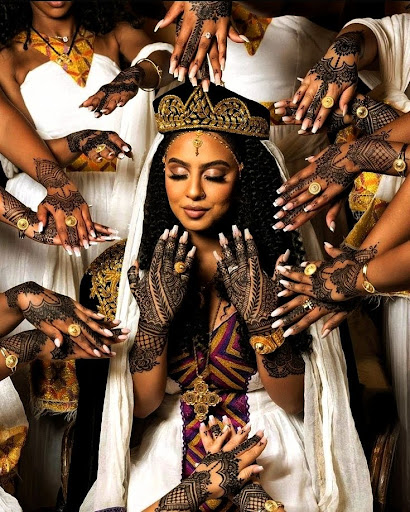In Ethiopia, a wedding is never just a ceremony; it is a grand symphony of tradition, faith, family, and festivity. It is witnessing together generations, communities, and cultures. With elaborate pre-wedding rituals to dazzling wedding attire, from the sacred vows to the feasts that follow, an Ethiopian wedding is a kind of celebration that lingers in memory long after the music fades.
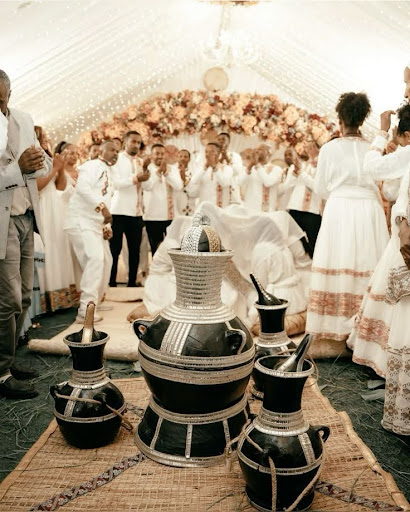
Courtship and Engagement
Though modern love stories increasingly begin in classrooms, workplaces, or cities, Ethiopia still holds strongly to the belief that marriage is as much about families as it is about two individuals. Traditionally, courtship begins with shimagelay, a formal negotiation led by elders from the groom’s family. Their role is to approach the bride’s household, offer respect, and secure the blessing of her parents.
Once the families agree, the engagement ceremony known as Telosh follows. On this day, the groom and his family arrive at the bride’s home with gifts: jewelry, perfumes, fabrics, and sometimes even an Ethiopian wedding dress woven from soft cotton. The bride, in turn, presents her future husband with gifts, symbolizing mutual respect. Far from being a quiet affair, Telosh brims with music, laughter, and playful teasing as women ululate and men break into song.
Pre-Wedding Preparations
The days before the wedding are rich with tradition. Brides are pampered in rituals of beauty – sometimes with honey and milk foot-washing, other times with elaborate henna designs across hands and feet, especially in Muslim communities. These moments are both symbolic and celebratory, preparing her to step into her new life adorned with grace.
Different regions bring unique flavors to the preparations. In the Gurage community, women gather for Ensosela, a lively female-only event filled with song. In Harari tradition, the groom’s family sends sweets and chat leaves to the bride’s home during the engagement, adding to the anticipation.
Ethiopian Wedding Attire
No Ethiopian wedding is complete without its iconic attire. The bride often shines in a habesha kemis, a flowing white cotton gown decorated with vibrant embroidery along the borders. These are sometimes modernized into Ethiopian wedding gowns, combining traditional handwoven fabrics with contemporary tailoring.
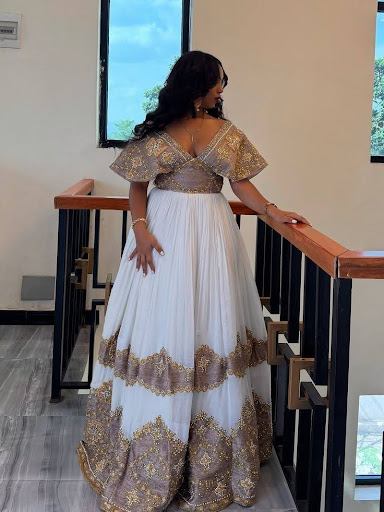
The groom, meanwhile, may wear a traditional Habesha libs, paired with a regal Kaba – a cape-like garment edged with gold embroidery. Together, the couple’s appearance is not just stylish; it reflects cultural pride.
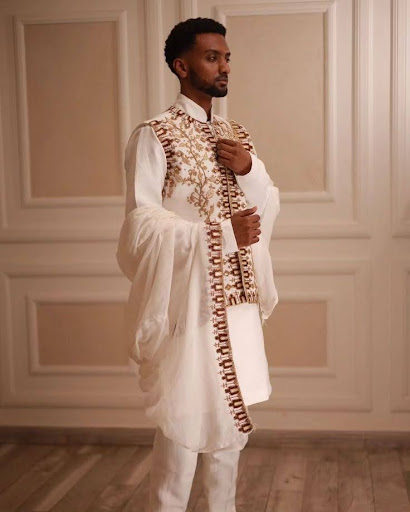
Among Harari brides, jewelry plays a starring role, from elaborate headpieces like the Siyaasa to layers of gold necklaces and bangles.
The Sacred Wedding Ceremony
Ethiopian weddings differ according to faith, but all are deeply symbolic.
- Ethiopian Orthodox Christian weddings often take place inside a church, with the priest blessing the couple and placing crowns on their heads, declaring them the king and queen of their new household. The ceremony, filled with incense and chanting, emphasizes the sanctity of marriage.
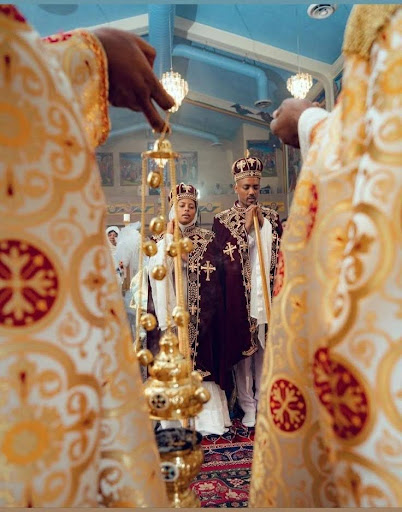
- Muslim weddings center on the Nikah, where vows are exchanged before God in the presence of an imam. Afterwards, families host a joyous celebration, complete with food, music, and dance.
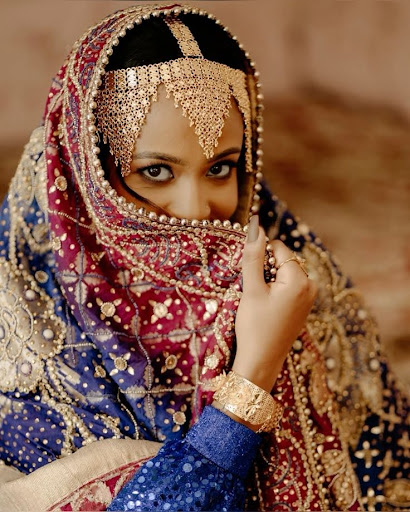
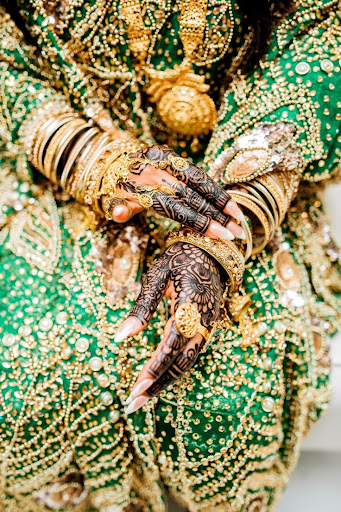
- Protestant and Catholic weddings tend to mirror Western services but still embrace Ethiopian traditions, whether through attire, music, or dance.
Across all faiths, the presence of elders, the blessings of parents, and the joy of the community are constants.
The Feast and the Famous Gursha
Once vows are exchanged, it’s time for the central highlight of any Ethiopian wedding. Guests gather around large platters of injera, topped with an array of stews and sautés: doro wat (spicy chicken stew), tibs (beef or lamb), and kitfo (minced beef with spiced butter).
What makes dining special is the act of gursha, which is feeding one another by hand. The bride and groom feed each other as a symbol of love and care, and soon, guests join in, feeding family members and friends as a sign of affection. Sweet tej (honey wine) flows in glass flasks called berele, while homemade tella (beer) adds to the cheer.
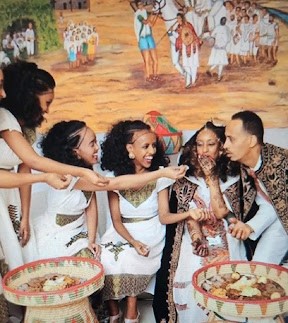
Celebrations: Music and Dance
Ethiopian weddings are famous for their music and dance. The eskista, a traditional dance of rolling shoulders and chest movements, electrifies the reception. Guests, young and old, join in, clapping and swaying as the rhythm builds. Professional dancers sometimes lead the crowd, ensuring the energy never wanes.
Celebrations often last well beyond the wedding day.
- Melse: The day after the wedding, the bride’s family hosts a gathering. The couple wears their finest Ethiopian wedding attire, often including the embroidered Kaba, and receives blessings from both families.
- Kelekel: On the third day, the party continues with more food, more dancing, more joy.
Beyond the grand celebrations, Ethiopian weddings are filled with small but meaningful customs.
- The Bread Name: In some traditions, the groom’s mother hides a loaf of bread, and the groomsmen must find it. If they fail, they pay a fine. Once found, the groom’s mother gives the bride a nickname, welcoming her into the family.
- Kneeling to Elders: Couples kneel before their parents and elders, kissing their knees or feet in a powerful act of respect. Elders then bless the union, reminding the couple that marriage is as much about heritage as it is about the future.
Ethiopia’s Cultural Tapestry
An Ethiopian wedding is not just a milestone for a couple, it is a cultural festival, a family reunion, and a communal feast. It is at once sacred and joyous, intimate and expansive. From the regal crowns of an Orthodox ceremony to the shoulder-shaking energy of eskista, from the elegance of an Ethiopian wedding dress to the tenderness of gursha, the celebration is one of the most dazzling expressions of love anywhere in the world.

